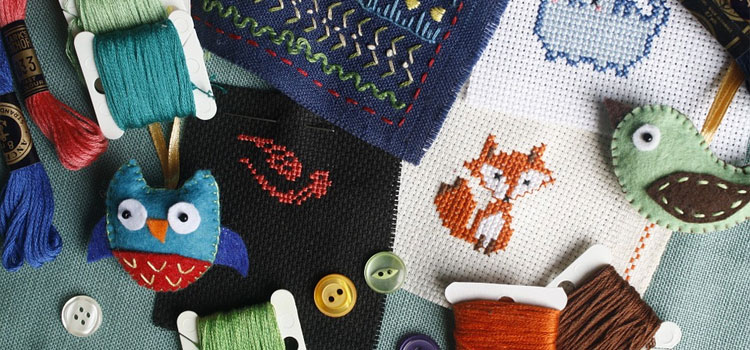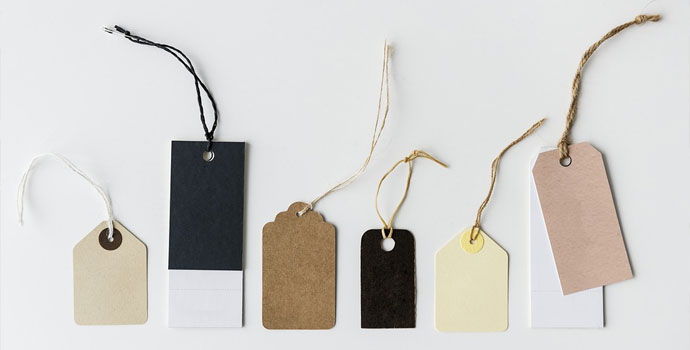Embroidered garments and accessories have been in style and in demand since the dawn of history, and they remain popular even now.
- Inbox Dollars - Get paid to check your email. $5 bonus just for signing up!
- Survey Junkie - The #1 survey site that doesn't suck. Short surveys, high payouts, simply the best.
- Nielsen - Download their app and get paid $50!
Whether you have a passing interest in embroidery, or it’s already a hobby for you, you probably want a piece of the potential profit from getting into the embroidery industry.
Here’s a guide on how to start an embroidery business: what you need to consider beforehand, what you need to prepare, and how you can establish your business.
Should You Start An Embroidery Business?
An embroidery business can definitely be profitable, but it may not be for everyone.
Here are some factors to consider before you start.
Space
Basic embroidery machines take up very little space; some are as small as an end table.
However, you have to have space for the other materials you need as well as your finished products for selling or for delivery.
Think about whether you have enough space in your home or in your garage for all these, or if you’ll eventually need to rent a space.
Costs
Will you be able to spring for the initial cost of the machinery and raw materials?
These do not cost much: a basic embroidery machine costs as low as $500 and a bobbin wound with 145 yards of white polyester thread costs as low as 18 cents.
But if you don’t have extra income to cover even that, then starting an embroidery business may not be for you.
Business objectives
Despite the many apparel decoration methods available (e.g., silkscreen printing, heat press, and direct-to-garment printing), and advances in the technology involved, embroidery will always stay in demand.

However, if you’re more knowledgeable or comfortable with other technologies apart from embroidery, then embroidery may not be a great place to start your apparel business.
Nevertheless, nothing can stop you from expanding your offerings to include other apparel printing types so you can target a more diverse target audience.
Ideal customer
Speaking of your target customer, it’s good to have an idea of who your ideal buyer is.
When you have a profile of your ideal buyer, you can assess yourself and decide if you have the skills and vision to meet your target customers’ needs.
What You Need Before You Start Your Embroidery Business
Once you’ve decided to go ahead with it, you’ll need to do some things first to prepare.
Here are the steps you need to take to ensure you’re prepared to open your embroidery business.
No joke. Here are the fastest ways to make easy money online. Click here to see how.
Self-Learning and Networking
You don’t have to have a college degree to start an embroidery business, but you do need to know plenty and you need to be updated.
Learn as much as you can about the apparel industry and especially the custom embroidery segment of that industry.
There are embroidery and custom apparel associations you can join to get the latest industry news and trends.
Look for trade shows to attend so you can network with suppliers and other business owners for advice on where to get the best supplies and how to run an embroidery business.
Read up on custom embroidery through online articles, journals, and books to learn the right techniques and the most current designs.
Most importantly, practice the skills necessary for this business: embroidery and design, as well as business management and marketing skills.
Market Research
“Market research” sounds intimidating, but it doesn’t need to be.
Market research is the process of gathering and analyzing data about a target market’s needs, triggers, and preferences.
The aim is for you to know who to offer your embroidery services to, what you can offer them, and how to offer your services to them.
The first thing you need to do is to draw up your buyer persona, which is a general, hypothetical representation of your ideal customer.
The point of this exercise is to be able to visualize who your target customer is so you can understand how they make their purchasing decisions and form your business and marketing strategy accordingly.
Discussing how to make a buyer persona will take up much space in this post, so here’s a guide on how to create a buyer persona.
An example of a niche you can go into is the commercial market, where you create embroidery for uniforms, corporate giveaways, or marketing materials.
Another example of a niche is the private market, where you make custom embroidery for personalized clothing, gift items, events, or parties for individuals.
There may be other niches that you can tease out during your market research that you might want to target.
Business Plan
A business plan is one of the most important documents that you’ll ever create and possess related to your embroidery business.
A written, well-organized business plan helps give your business a clear direction and how you’re going to achieve your goals.
That said, it doesn’t have to be formal unless you’re going to submit it as a requirement to get a small business loan.
You can make money from home and it doesn't have to be challenging. Click here to see how.
It doesn’t even have to be 100 pages; who would read such a long document?
As long as it is easily understandable and all of the essential information is included, that’s an acceptable business plan.
Remember that you’re going to refer back to your business plan from time to time, and you should also be able to edit and refine this document as your business changes and grows.
Keep this document where you can easily access it anywhere, anytime, preferably in a cloud drive.
Here, in a nutshell, are the essential elements that you need to include in your business plan:
- Executive summary
- Company profile
- Organization (when you do expand your business and hire employees)
- Market research
- Product/Services offered
- Marketing plan
- Financial plan
The executive summary is your business in a nutshell: who you are, what you offer, and your target market. If you can, limit this to one or two sentences.
While this is the first thing that readers will read on your business plan, it’s advisable to create this last. After all, this is a summary of everything else on your business plan.
On the other hand, the company profile is a bit more detailed description of your business, the specific products and services you offer, details of your target market, and your advantage over your competitors.
Running an embroidery business can be daunting, especially if you handle all the steps from sales and marketing to design, creation, shipping, and aftersales.
You’ll probably hire some people to work with you at some point, and when you do, include an organizational chart to your business plan.
Details of your market research would certainly be needed in your business plan to establish who your target audience is, what their needs are, and how their problems are being solved by your competitors.
Your business plan should also include a complete, detailed list of the products and services you’re offering.
As your target market’s needs evolve and your business evolves, you should be able to add and remove items on this list.
Your marketing and sales plan should include how you plan on reaching your target market and selling to them, your promotion strategy, your pricing plan, as well as partnerships you plan to make, if any, to help further your business interests.
A typical financial plan should have a sales forecast with your gross projected income and your direct costs that eat into the income.
Also include your indirect costs, which are expenses that are associated with running the business, such as rent and utilities. Marketing and promotional costs are also normally included here.
Aside from these sections describing your business, bear in mind that you need to express your passion and dedication.
Don’t hesitate to state your values, challenges, strengths, and what makes you stand out from your competitors.
Even if you’re the only one who ends up reading your business plan, rereading it and reconnecting with the passion that you have for your business allows you to get your bearings back when you’re feeling lost.
Embroidery Machine
Here are some factors to consider when shopping for the best embroidery machine for your business.
- Brand
- Value for money
- Ease of use
- Automated processes
- Embroidery area
- Connectivity
- Compatibility with digitizing software
- Warranty
- Support and training
Name brands of embroidery machines tend to have the best features and aftersales support, but just because a machine is expensive doesn’t necessarily mean it’s the best.
Consider what you’re getting for the price you’re paying. You may be paying too much for too few features or features that are of no use to you.
Also consider how easy the machine is to use, and which processes are automated, such as automatic thread tension and cutting, needle threading, bobbin winding, and other minor processes.
These may seem frivolous, but the time you take to do all this manually is time that you could have put into actual embroidery.
Another largely overlooked feature is the embroidery area. A bigger area allows you to create larger designs and gives you the space to create more complicated designs.
You’ll also want an embroidery machine that has plenty of connectivity options to a computer for uploading designs.
At the very least, it should have a USB connection so you can use a thumb drive or connect it directly to a computer.
Wireless connectivity is an obvious plus, but if you’re going to be working in close quarters with a single machine, then a USB connection should be enough.
Because everything is digital now, another feature you should be looking for is how compatible your machine is with digitizing software so you can work with digital designs.
Don’t forget to check out the warranty that’s included in your purchase and what’s covered. Also, consider whether they cover shipping costs for replacements and for repair jobs that have to be done in their facilities.
Customer service is another aspect to consider; what channels are available during what hours, and whether they’re genuinely helpful and reliable.
Of course, even the best embroidery machine would be useless in the hands of an unskilled operator.
Make sure you train yourself in the use of the machine that you end up buying. Take advantage of available training, whether free or paid, online or offline.
Raw Materials
Your raw materials will largely depend on your customers’ needs, so you don’t want to stock up on too many spools and bobbins of embroidery threads and too many needles.
However, you’ll want to research all the best places to source your raw materials from.
Amazon carries pretty much everything you need to start, as well as on an as-needed basis.
Gunold is another online store, but this one specializes in discount embroidery supplies. They also offer a wealth of resources and workshops to help you hone your embroidery skills.
How To Start Your Embroidery Business
At this point, you’re probably feeling like you’ve run a couple of marathons.
But it’s worth putting everything in place so you can get off to a great start.
Here’s how to (finally) get started with your embroidery business.
1. Register your business.
You can hold off on this for later, but it’s advisable to get the proper licenses and registration as early as you can.
Registering as an LLC is recommended because then, your liability is limited to the amount of your investment in the business, and you needn’t dip into your personal savings fund if you ever get into debt or litigation as long as you’re careful to keep separate records.
Remember that embroidery is a creative job as much as it is a labor-intensive one.
Being registered as a business also gives you the advantage of being able to apply for copyrights and other intellectual property claims for your designs.
Register with the IRS as well so you can take advantage of the tax benefits as well as wholesale prices from suppliers.
The requirements for getting licenses differ for each state, so call your local government offices to know exactly what you need to file and submit.
2. Determine your pricing strategy.
Creating a pricing strategy can be a bit sticky, especially for an embroidery business, which deals in custom, personalized outputs.
When drawing up a pricing strategy, remember these factors that you should consider: the price of the raw materials, the complexity or intricacy of the design, the actual size of the design, and how much time it will take to finish.
Of all these, it’s the time to do the job seems to be the most overlooked, so what you can do is to have a target profit per hour in mind, then factor in all the other costs to come up with a fair price.
3. Decide what to sell.
When you’re starting from scratch, you’ll want to probably start with a few small projects first to build your confidence and show off your skills.
Small projects include patches to attach to clothes, or small garments and items, such as onesies, handkerchiefs, face towels, coasters, holiday stockings, and other such items.
And then you can move on to larger projects like embroidered shirts, jeans, and dresses.
However, there are plenty of embroidered items for sale on other stores, so the ultimate goal really is to get orders of personalized items with custom designs, either for corporate clients or individuals for holiday gifts and events.
4. Choose where to sell.
First, decide if you’re going to offer your products/services online, locally, or both.
You can sell your projects on a number of online platforms, such as Etsy, eBay, and Amazon Handmade.
Here’s an interesting read if you’re debating whether to go with Etsy or eBay.
If you want to set up a physical storefront instead of or in addition to your online shop, set up your space accordingly.
Make sure that aside from your embroidery machine, your materials, and your basic office (laptop plus files), you have a suitable place to display finished work and to entertain customers who want to commission embroidery.
Also, if you’re going to have a physical location, it’s advisable to register your embroidery business on Google My Business so that potential customers in your area can easily find your business.
5. Set up your online presence.
Given the world we live in now, an online presence is an absolute necessity for any business that wants to be successful.
Whether or not you decide to conduct business online, your possible customers are expecting to be able to research you and connect with you online.
However, don’t feel you need to sign up for all conceivable social media sites. Embroidery is very visual, so show off your work on visual platforms like Instagram and Facebook.
Social media marketing is very important, but having your own website, whether or not you turn it into an e-commerce site, is going to open plenty of marketing and promotional opportunities for your embroidery business.
6. Organize your contact information.
The basic principle is to keep your personal contact information separate from that of your business as much as you can.
Technically, you can have your home address as your business address, or your so-called Registered Agent address.
The only problem with this is that Registered Agent databases are public record, and I imagine you wouldn’t want to have your home address made public.
To keep your home address private, you can either get a mailbox through UPS or use the address of a co-working space.
You can also hire a virtual business address service that provides a physical address as well as a mail scanning service that weeds out junk mail and sends you digital copies of the important ones.
An easier hurdle is getting a dedicated phone line for your business.
You’d want a business phone that you can turn off when you’re not working as well as a smartphone by which you can do social media updates.
A separate business email is also advisable, though that should be taken care of if you set up your own website.
Starting An Embroidery Business: The Bottom Line
An embroidery business is one that does not require any bachelor’s degrees or formal training; the quality of your work speaks for itself.
Hopefully, today’s article has inspired you to start your own embroidery business today.
Embroidery isn’t the only business you can run online. Here are more online businesses to consider starting.
If you’ve changed your mind about starting a business and are only looking to work from home, here are 90 work from home jobs you can try your hand at.
Did this article make you want to start your own embroidery business, or did it make you realize you want something else?
Tell us your stories below!








